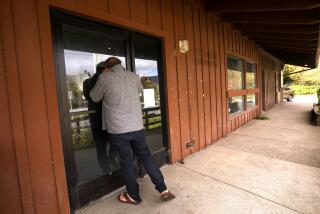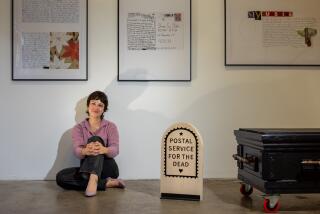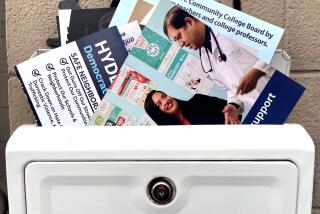Rural Mailboxes Deliver as Folk Artworks
PROVIDENCE, R.I. — Deck a country mailbox with cornstalks, chickens or cowboy motifs and you may have a work of folk art, two connoisseurs believe. The artists are creative customers along Rural Free Delivery routes around the nation who personalize their mailboxes.
The dedicated art historians of this minor genre of Americana are two Rhode Island anthropologists, William and Sarah Turnbaugh. They are tracking down the boxes to record them before they disappear from the American landscape.
Farmers began getting home mail delivery 100 years ago after they protested having to pick it up at the post office.
Whoever else noticed the centennial, the Turnbaughs did. It’s their hobby to photograph mailboxes they consider folk art.
This mailbox mania started when the couple was driving on a back road in Nebraska about 10 years ago. This was one of many trips they’ve made to visit American Indian reservations, museums and “other legitimate anthropological stuff,” Turnbaugh, a University of Rhode Island professor, said.
“We spotted a little blue cowboy made entirely out of pipes. They had shaped him so he was running, and the mailbox was held out in front of him. And it struck us as a remarkable little creature,” Turnbaugh said.
Since then, they’ve collected hundreds of pictures of American postal history. In 1988, they published “R.F.D. Country! Mailboxes and Post Offices of Rural America,” written under the pen name of Thornbrook.
Last year, they presented a slide show of photos of more than 100 mailboxes at the National Postal Museum in Washington. “What they’ve tried to do is show how creative we as a people are,” said Jim Bruns, director of the Postal Museum, a 1993 addition to the Smithsonian Institution.
“My particular favorite was a mother and baby dolphin, and you’d have to open the nose of the mother dolphin,” Bruns said.
“Another was a Midas muffler shop that had created a mailbox from a muffler. They made a muffler man: his head was a break drum, his body was a muffler, his arms and legs were tailpipes and he held a smaller muffler in his hand and that was the mailbox.”
Sarah Turnbaugh still recalls mailboxes that got away from them--like that 10-foot cornstalk mailbox pictured at a rest stop in Iowa. They tried to find the original at a local farm but got lost.
“That was one we really regretted. But there are always some really ingenious ones around another bend in the road,” said Turnbaugh, who directs the Museum of Primitive Art and Culture in South Kingstown, R.I.
Among them: boxes set on top of antique milk bottles, cream separators, blacksmith tools and plows that date to at least the turn of the century. And boxes decorated with sheet metal cut and painted into the shapes of pigs, cows, horses, cowboys and American Indians.
They are also fond of air-mail boxes, set up high as if an airplane were delivering the mail, Turnbaugh said.
Another favorite was near their Narragansett home. Antonietta Goodwin, a farm owner who died last year, had decorated her mailboxes with two plastic chickens.
“She made hundreds of outfits for these chickens, and she would switch them around. She had trick-or-treaters for Halloween, Santa Claus, and bunny chickens for Easter.”
For this, she was known as the “Chicken Lady.”
“For a lot of people, decorating their mailbox is a way of expressing themselves and announcing themselves,” Turnbaugh said.
“It can be anything from rebelliousness against a standard society, or a way to make use of useless junk in the yard.”
More to Read
Sign up for Essential California
The most important California stories and recommendations in your inbox every morning.
You may occasionally receive promotional content from the Los Angeles Times.










